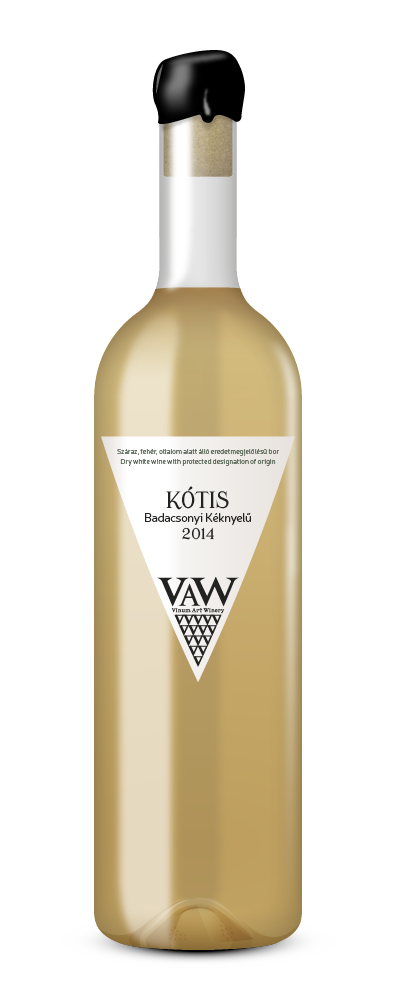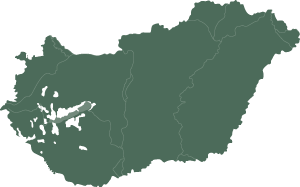Personal opinion:
This Blue Stem variety, that is mostly or only present in Badacsony, is characterized by steeliness and directness. We bottle this fine and elegant wine after nine months of maturation. Its aroma is sharp, its flavours are full. It carries rather masculine characteristics.
Gastronomical pairing:
I am not saying everyone can easily make this to accompany this wine but what I got besides the Balaton panorama was grilled duck liver with potato balls and fresh salad with marinated walnuts and raspberry vinegar. Yummy!
About the Kéknyelű or “Blue Stem” variety:
The Kéknyelű is an ancient Hungarian variety that was expressedly only grown in Hungary. The variety received its name after its rachis of bluish colour. Its stock is of medium strength, robust, with flatted canes. Its leaves are medium-sized and round, The berries are medium-sized, round, greenish white, dotted and thick-skinned. Its cluster is medium-sized, slightly short and thick-set, loose sometimes incomplete. It is sensitive to frost but is tolerant of drought and does not rot. It has a female flower, its main stamen variety is the Budai Green therefore it is usually planted together with that.
It does not yield big quantities but usually good quality.
Local peasants used to call it "gentlemen's grapes" because of the quantity of the harvest. Since their living depended on the quantity of the fruit that could be harvested, they only looked at its cultivation as gentleman's passion.
In spite of this it used to be a popular and expensive variety before the phylloxera epidemic. It was played down after World War 2, in the 2000's, however, it again received the well-deserved attention, and is planted at more and more locations. Its wine belongs to the rustic types, the flavour of which is simple, pleasant already at a young age, but gives real joy after several years of maturation.
The region and its history:
In the Badacsony area, vines were grown in Roman times, and Emperor Probus had sizeable plantings here. At the time of the settlement of the Magyars in Hungary they already knew about vines and wine. They appreciated areas capable of growing vine. A significant part of the wine region was taken over by the church in the 13th century. In the 18th-19th century the Badacsony vermouth gained a similar reputation to that of the Tokaj aszú in Europe.
During the reconstruction after the phylloxera epidemic, supporting walls were built to prevent soil erosion. New varieties also entered the area. The Szürkebarát was introduced from France by monks. Due to the special soil content it evolved into a typical local variety, the Szürkebarát, which botrytises in good years.
The variety grown in the biggest amount is Olaszrizling that is in better years ripened on the stock longer, and is used to make ice wine or late-harvest hand-selected Olaszrizling. Szürkebarát, Tramini, Sárga muskotály, Rajnai rizling and Chardonnay are also present on the larger lands.
Kéknyelű or " Blue Stem" used to be a characteristic wine of the region. It was significantly confined by the frost damage of the 1980's but is experiencing a revival today, and will be an emblematic wine of the Badacsony region again in the near future.
Badacsony wines are typically full-bodied, fiery, aromatic and mineralized. Traditional wine-making and maturation in wooden barrels are characteristic. Although reductive wine-making and other modern technologies are also spreading, they have not significantly changed the character of the region's wine, yet.
Climate and geography:
Badacsony is the highest mountain in the Tapolca Basin; it stands between two bays of Lake Balaton. The circumference of the almost round mountain is 11km, the diametre of its top region slightly elongated in the north-south direction is 1-1.5km, its highest point is 437.4 metres above sea level. Its hillside is covered up to 280 metres by various loose deposits that are excellent for growing vine, and its soil is basalt-based loess. It is covered by various loose deposit, Pannon clay and Pannon loess, above which there are basalt rocks. Its climate is mild and balanced with high humidity. Because of the proximity of Lake Balaton the southern hills can also enjoy the sunshine reflected from the surface of the water, therefore there is a very beneficial microclimate that makes the making of natural dessert wine possible.
The wine region includes the vine cadastre-based first and second class border sections of the following settlements: Ábrahámhegy, Badacsonytomaj, Badacsonytördemic, Balatonrendes, Balatonszepezd, Diszel, Gyulakeszi, Hegymagas, Káptalantóti, Kisapáti, Kővágóörs, Nemesgulács, Raposka, Révfülöp, Salföld, Szigliget, Tapolca.
NAME: KÓTIS
YEAR: 2014
VARIETY: Kéknyelű
WINE REGION: Badacsony
CLASS: Dry white wine with protected designation of origin
Product of Hungary
Bottle volume: 750ml
Alc. 12%vol
Contains sulphites


